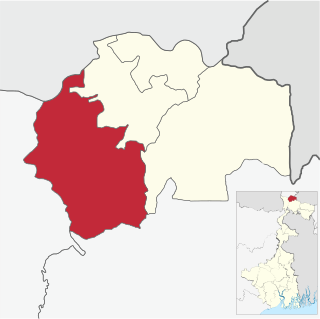Related Research Articles

Darjeeling is a city in the northernmost region of the Indian state of West Bengal. Located in the Eastern Himalayas, it has an average elevation of 2,045 metres (6,709 ft). To the west of Darjeeling lies the easternmost province of Nepal, to the east the Kingdom of Bhutan, to the north the Indian state of Sikkim, and farther north the Tibet Autonomous Region region of China. Bangladesh lies to the south and southeast, and most of the state of West Bengal lies to the south and southwest, connected to the Darjeeling region by a narrow tract. Kangchenjunga, the world's third-highest mountain, rises to the north and is prominently visible on clear days.

Kalimpong is a town and the headquarters of an eponymous district in the Indian state of West Bengal. It is located at an average elevation of 1,250 metres (4,101 ft). The town is the headquarters of the Kalimpong district. The region comes under Gorkhaland Territorial Administration which is an autonomous governing body within the state of West Bengal. The Indian Army's 27 Mountain Division is located on the outskirts of the city.

Gorkha National Liberation Front (GNLF) is a political party in the Darjeeling District of West Bengal, India. It was formed in 1980 by Subhash Ghisingh with the objective of demanding a Gorkhaland state within India.

Bagdogra is a settlement in the Naxalbari CD block in the Siliguri subdivision of the Darjeeling district, in the Indian state of West Bengal. It is a part of the Greater Siliguri Metropolitan Area. Bagdogra is well connected by air to six major cities of India – Delhi, Mumbai, Bengaluru, Hyderabad, Kolkata and Chennai through the Bagdogra Airport. The Bagdogra railway station is also well connected.

Darjeeling District is the northernmost district of the state of West Bengal in eastern India in the foothills of the Himalayas. The district is famous for its hill station and Darjeeling tea. Darjeeling is the district headquarters.

Kurseong is a town and a municipality in Darjeeling district in the Indian state of West Bengal. It is the headquarters of the Kurseong subdivision.

The Gorkhaland movement is a campaign to create a separate state of India in the Gorkhaland region of West Bengal for the Nepali-speaking Indians. The proposed state includes the hill regions of the Darjeeling district, Kalimpong district and Dooars regions that include Jalpaiguri, Alipurduar and parts of Cooch behar districts. A demand for a separate administrative unit in Darjeeling has existed since 1909, when the Hillmen's Association of Darjeeling submitted a memorandum to Minto-Morley Reforms demanding a separate administrative setup.
The administrative divisions of India are subnational administrative units of India; they are composed of a nested hierarchy of administrative divisions.
Darjeeling Gorkha Hill Council, also once known for a short period of time as Darjeeling Gorkha Autonomous Hill Council, was a semi-autonomous body that looked after the administration of the hills of Darjeeling District in the state of West Bengal, India. DGHC had three subdivisions under its authority: Darjeeling, Kalimpong, and Kurseong and some areas of Siliguri subdivision.

Indian Gorkhas, also known as Nepali Indians, are an ethno-cultural group native to India, who speak Nepali as a common language. They inhabit mainly the states of Sikkim, West Bengal, Northeast and Uttarakhand, including their diaspora elsewhere in India and abroad. The modern term "Indian Gorkha" is used to differentiate the Nepali language Speaking Indians from Nepalis.

Darjeeling Pulbazar is a community development block that forms an administrative division in the Darjeeling Sadar subdivision of the Darjeeling district in the Indian state of West Bengal.

Jorebunglow Sukhiapokhri is a community development block that forms an administrative division in the Darjeeling Sadar subdivision of the Darjeeling district in the Indian state of West Bengal.

Rangli Rangliot is a community development block that forms an administrative division in the Darjeeling Sadar subdivision of the Darjeeling district in the Indian state of West Bengal.

Kalimpong I is a community development block that forms an administrative division in the Kalimpong subdivision of the Kalimpong district in the Indian state of West Bengal.

Kalimpong II was a community development block that forms an administrative division in the Kalimpong subdivision of the Kalimpong district in the Indian state of West Bengal.

Gorubathan is a community development block that forms an administrative division in the Kalimpong subdivision of the Kalimpong district in the Indian state of West Bengal.

Mirik is a community development block that forms an administrative division in the Mirik subdivision of the Darjeeling district in the Indian state of West Bengal.

Kurseong is a community development block that forms an administrative division in the Kurseong subdivision of the Darjeeling district in the Indian state of West Bengal.

Kalimpong district is a district in the state of West Bengal, India. In 2017, it was carved out as a separate district to become the 21st district of West Bengal.

Parasmani Pradhan was an Indian Nepali-language writer, poet, translator, grammarian, educator and publisher. He published multiple Nepali language textbooks and played an important role in shaping the modern Nepali grammar. He was one of the key figures who contributed in establishing Nepali as one of the official language of India.
References
- ↑ Dasgupta 1999, pp. 61–62.
- 1 2 Bagchi 2012.
- ↑ Chatterjee 2020, p. 70.
- 1 2 Sen 1989, pp. 107–108.